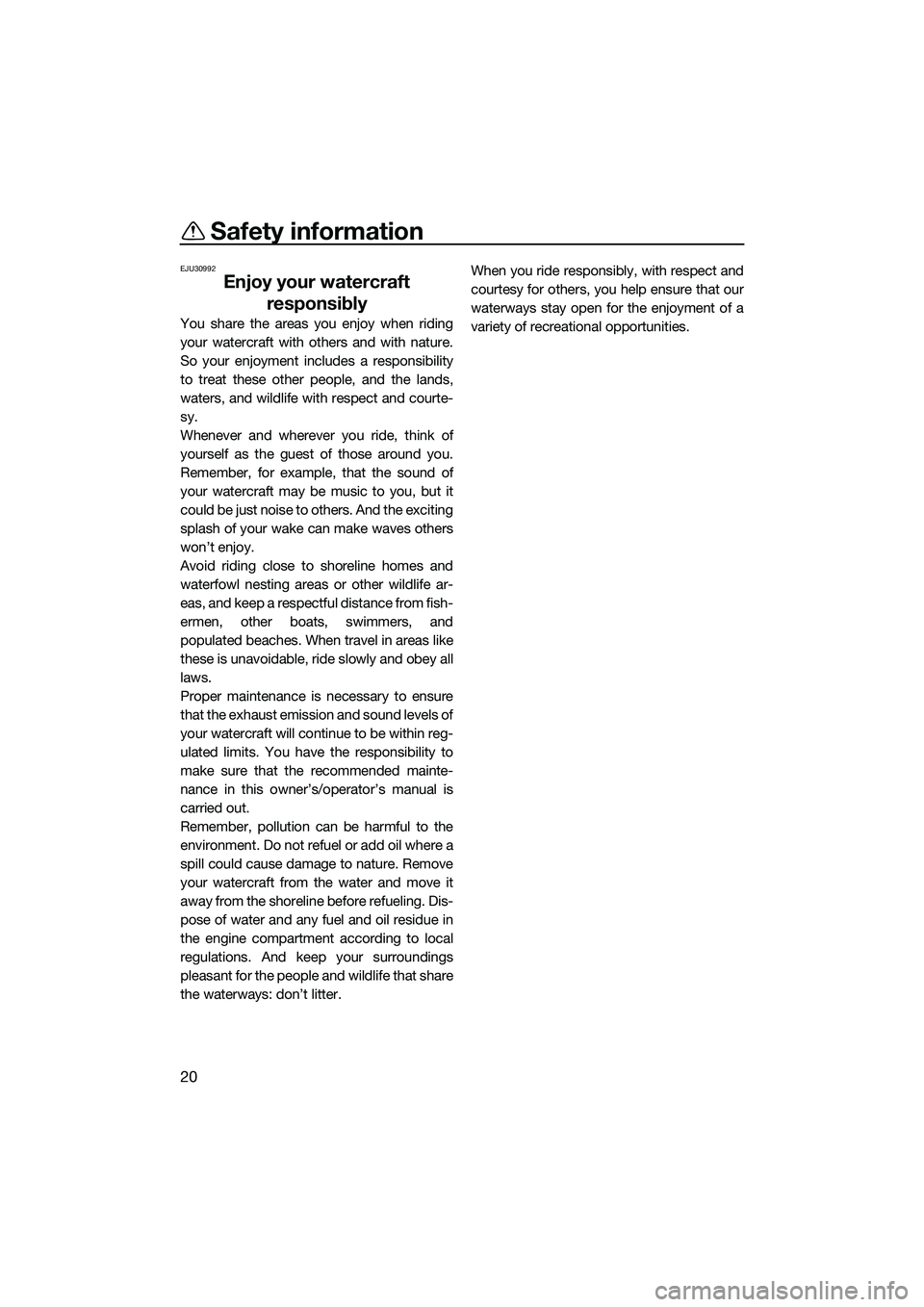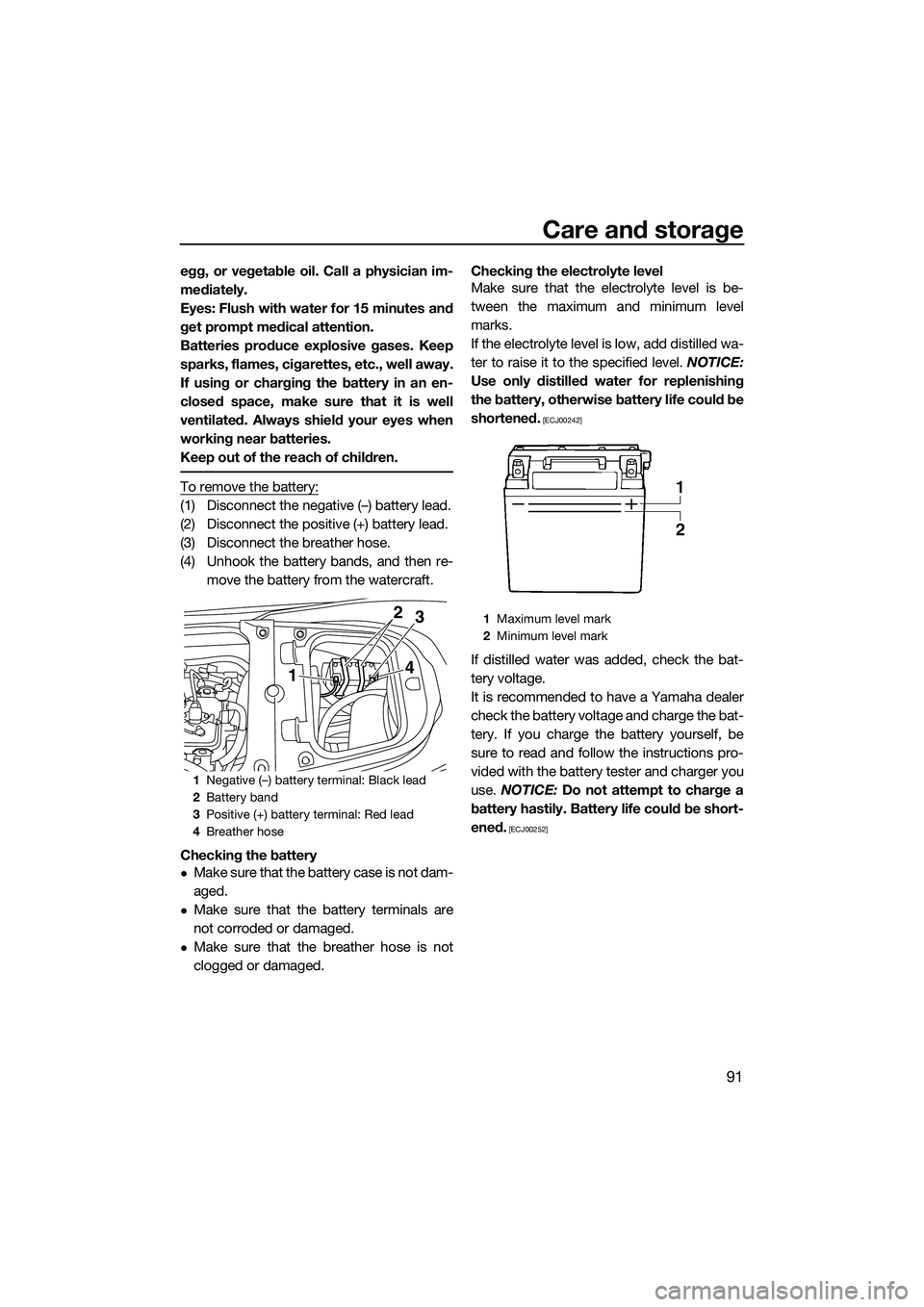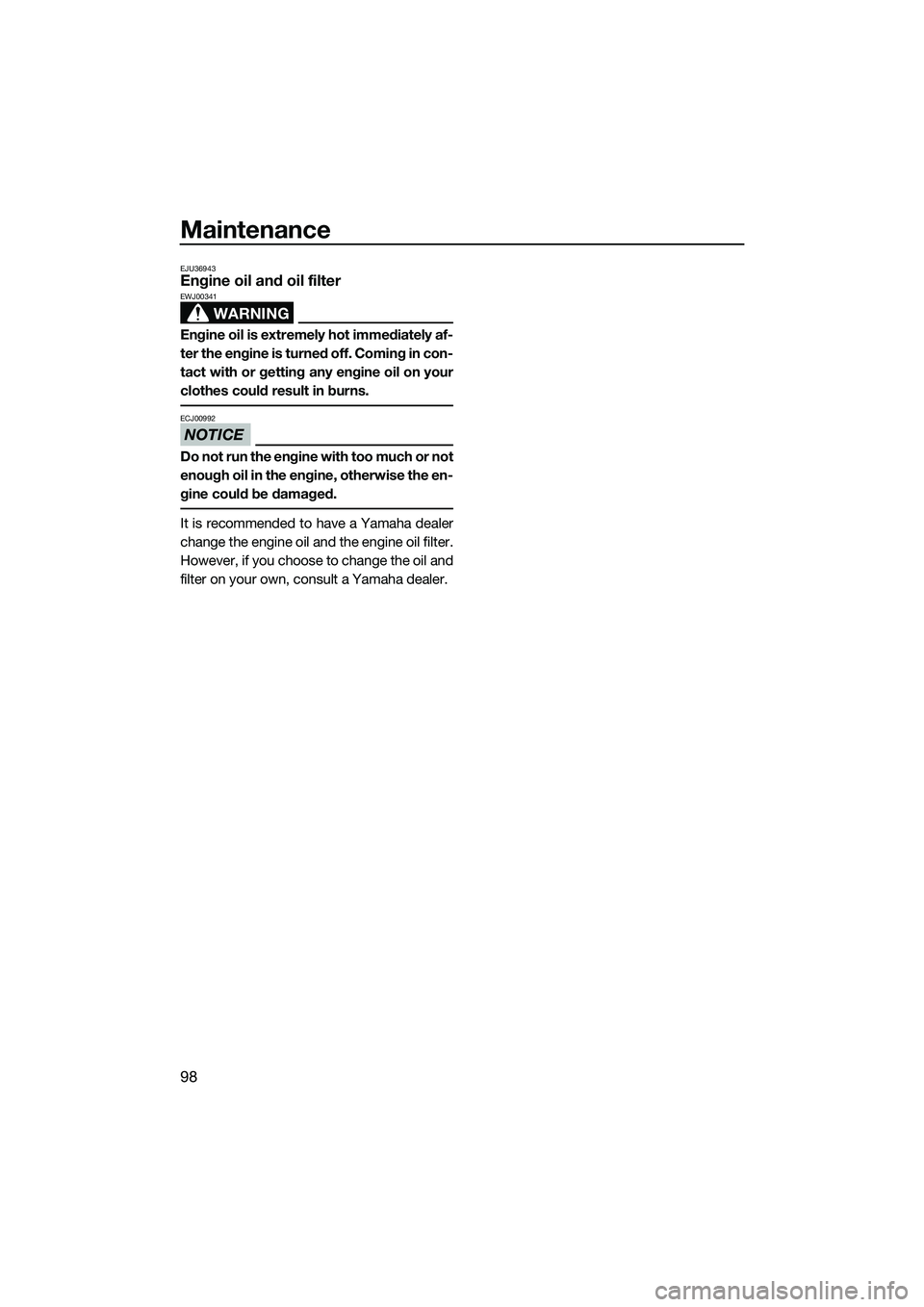2015 YAMAHA FX SVHO recommended oil
[x] Cancel search: recommended oilPage 5 of 118

Table of contents
General and important labels ........... 1Identification numbers .................... 1
Primary Identification (PRI-ID)
number............................................ 1
Craft Identification Number (CIN) ....... 1
Engine serial number.......................... 1
Manufactured date label .................... 2
Model information ........................... 2
Builder’s plate .................................... 2
Important labels .............................. 4
Warning labels.................................... 5
Other labels ........................................ 9
Safety information ........................... 11 Limitations on who may operate the watercraft ............................. 11
Cruising limitations ........................ 12
Operation requirements ................ 13
Recommended equipment ........... 15
Hazard information........................ 16
Watercraft characteristics ............. 16
Wakeboarding and water-skiing ... 18
Safe boating rules ......................... 19
Enjoy your watercraft responsibly ................................. 20
Description....................................... 21 Watercraft glossary ....................... 21
Location of main components ...... 22
Control function operation ............. 26 Watercraft control functions ......... 26
Remote control transmitter .............. 26
Yamaha Security System ................. 27
Engine stop switch .......................... 28
Engine shut-off switch .................... 28
Start switch ..................................... 28
Throttle lever .................................... 29
RiDE lever ......................................... 29
Steering system ............................... 29
Adjustable tilt steering system ......... 30
Cooling water pilot outlets ............... 31
Water separator................................ 31
Watercraft operation ...................... 32Watercraft operation functions ..... 32
Shift system...................................... 32
Electric trim system .......................... 34
Watercraft operation modes ......... 36
Low RPM Mode ............................... 36
No-wake mode ................................. 37
Cruise assist ..................................... 38
Instrument operation ...................... 40Multifunction information center ... 40
Analog speedometer/tachometer..... 40
Information display ........................... 41
Multifunction display ........................ 45
Equipment operation ...................... 50Equipment..................................... 50
Seats ................................................ 50
Handgrip........................................... 51
Reboarding grip................................ 51
Reboarding step ............................... 51
Bow eye............................................ 52
Stern eyes ........................................ 52
Cleat ................................................. 52
Pull-up cleats (FX Cruiser SVHO) ..... 53
Storage compartments .................... 53
Fire extinguisher holder and cover ... 58
Operation and handling
requirements ................................... 59Fuel requirements ......................... 59
Fuel................................................... 59
Engine oil requirements ................ 61
Engine oil .......................................... 61
Draining the bilge water ................ 63
Draining the bilge water on land....... 63
Draining the bilge water on water .... 63
UF3J71E0.book Page 1 Friday, June 27, 2014 1:50 PM
Page 26 of 118

Safety information
20
EJU30992
Enjoy your watercraft responsibly
You share the areas you enjoy when riding
your watercraft with others and with nature.
So your enjoyment includes a responsibility
to treat these other people, and the lands,
waters, and wildlife with respect and courte-
sy.
Whenever and wherever you ride, think of
yourself as the guest of those around you.
Remember, for example, that the sound of
your watercraft may be music to you, but it
could be just noise to others. And the exciting
splash of your wake can make waves others
won’t enjoy.
Avoid riding close to shoreline homes and
waterfowl nesting areas or other wildlife ar-
eas, and keep a respectful distance from fish-
ermen, other boats, swimmers, and
populated beaches. When travel in areas like
these is unavoidable, ride slowly and obey all
laws.
Proper maintenance is necessary to ensure
that the exhaust emission and sound levels of
your watercraft will continue to be within reg-
ulated limits. You have the responsibility to
make sure that the recommended mainte-
nance in this owner’s/operator’s manual is
carried out.
Remember, pollution can be harmful to the
environment. Do not refuel or add oil where a
spill could cause damage to nature. Remove
your watercraft from the water and move it
away from the shoreline before refueling. Dis-
pose of water and any fuel and oil residue in
the engine compartment according to local
regulations. And keep your surroundings
pleasant for the people and wildlife that share
the waterways: don’t litter. When you ride responsibly, with respect and
courtesy for others, you help ensure that our
waterways stay open for the enjoyment of a
variety of recreational opportunities.
UF3J71E0.book Page 20 Friday, June 27, 2014 1:50 PM
Page 67 of 118

Operation and handling requirements
61
fuel filler cap and the hood are securely
closed before using the watercraft.
(11) Securely install the seats in their original positions.EJU40291
Engine oil requirementsEJU41513Engine oil
NOTICE
ECJ00282
Use only 4-stroke engine oil. Usage of 2-
stroke engine oil could result in severe en-
gine damage.
TIP:
When the engine is operated at high speeds,
some engine oil may be consumed. Be sure
to check the engine oil level.
Checking the engine oil level
WARNING
EWJ00341
Engine oil is extremely hot immediately af-
ter the engine is turned off. Coming in con-
tact with or getting any engine oil on your
clothes could result in burns.
NOTICE
ECJ01002
Make sure that debris and water do not
enter the oil filler hole. Debris and water in
the engine oil can cause serious engine
damage.
To check the engine oil level:
(1) Place the watercraft in a precisely levelposition on land with the engine
stopped. If the engine was running, allow
the engine oil to settle by waiting 5 minu-
tes or more before checking the oil level.
(2) Remove the seats. (See page 50 for seat removal and installation procedures.)
Recommended engine oil type:SAE 10W-30, 10W-40, 20W-40,
20W-50
Recommended engine oil grade: API SE,SF,SG,SH,SJ,SL
UF3J71E0.book Page 61 Friday, June 27, 2014 1:50 PM
Page 97 of 118

Care and storage
91
egg, or vegetable oil. Call a physician im-
mediately.
Eyes: Flush with water for 15 minutes and
get prompt medical attention.
Batteries produce explosive gases. Keep
sparks, flames, cigarettes, etc., well away.
If using or charging the battery in an en-
closed space, make sure that it is well
ventilated. Always shield your eyes when
working near batteries.
Keep out of the reach of children.
To remove the battery:
(1) Disconnect the negative (–) battery lead.
(2) Disconnect the positive (+) battery lead.
(3) Disconnect the breather hose.
(4) Unhook the battery bands, and then re-move the battery from the watercraft.
Checking the battery
Make sure that the battery case is not dam-
aged.
Make sure that the battery terminals are
not corroded or damaged.
Make sure that the breather hose is not
clogged or damaged. Checking the electrolyte level
Make sure that the electrolyte level is be-
tween the maximum and minimum level
marks.
If the electrolyte level is low, add distilled wa-
ter to raise it to the specified level.
NOTICE:
Use only distilled water for replenishing
the battery, otherwise battery life could be
shortened.
[ECJ00242]
If distilled water was added, check the bat-
tery voltage.
It is recommended to have a Yamaha dealer
check the battery voltage and charge the bat-
tery. If you charge the battery yourself, be
sure to read and follow the instructions pro-
vided with the battery tester and charger you
use. NOTICE: Do not attempt to charge a
battery hastily. Battery life could be short-
ened.
[ECJ00252]
1 Negative (–) battery terminal: Black lead
2 Battery band
3 Positive (+) battery terminal: Red lead
4 Breather hose
143
2
1
Maximum level mark
2 Minimum level mark
UF3J71E0.book Page 91 Friday, June 27, 2014 1:50 PM
Page 104 of 118

Maintenance
98
EJU36943Engine oil and oil filter
WARNING
EWJ00341
Engine oil is extremely hot immediately af-
ter the engine is turned off. Coming in con-
tact with or getting any engine oil on your
clothes could result in burns.
NOTICE
ECJ00992
Do not run the engine with too much or not
enough oil in the engine, otherwise the en-
gine could be damaged.
It is recommended to have a Yamaha dealer
change the engine oil and the engine oil filter.
However, if you choose to change the oil and
filter on your own, consult a Yamaha dealer.
UF3J71E0.book Page 98 Friday, June 27, 2014 1:50 PM
Page 105 of 118

Specifications
99
EJU34543
Specifications
Watercraft capacity:
Maximum people on board:3 person
Maximum load capacity: 240 kg (530 lb)
Dimensions:
Length:
3560 mm (140.2 in)
Width: 1230 mm (48.4 in)
Height: 1230 mm (48.4 in)
Dry weight: FX SVHO 378 kg (833 lb)
FX Cruiser SVHO 379 kg (836 lb)
Performance:
Maximum output (according to ISO 8665/SAE
J1228):183.9 kW@7500 r/min
Maximum fuel consumption:
77.7 L/h (20.5 US gal/h, 17.1 Imp.gal/h)
Cruising range at full throttle: 0.90 hour
Trolling speed: 1250 ±100 r/min
Engine:
Engine type:
Liquid cooled 4-stroke, DOHC
Number of cylinders: 4
Engine displacement:
1812 cm³
Bore × stroke:
86.0 × 78.0 mm (3.39 × 3.07 in)
Compression ratio: 8.5 : 1
Valve clearance-intake (cold):
0.14–0.23 mm (0.0055–0.0091 in)
Valve clearance-exhaust (cold): 0.36–0.45 mm (0.0142–0.0177 in)
Lubrication system: Wet sump
Cooling system:
Water
Starting system: Electric Ignition system:
T.C.I.
Spark plug: LFR7A
Spark plug gap:
0.8–0.9 mm (0.031–0.035 in)
Battery capacity: 12 V, 19 Ah
Charging system: Flywheel magneto
Drive unit:
Propulsion system:Jet pump
Jet pump type: Axial flow, single stage
Impeller rotation: Counterclockwise
Jet thrust nozzle angle:
24.0+24.0 °
Jet thrust nozzle trim angle: -6, -3, 0, 3, 6 °
Fuel and oil:
Recommended fuel:
Premium unleaded gasoline
Minimum octane rating (PON): 91
Minimum octane rating (RON): 95
Recommended engine oil type SAE:
SAE 10W-30, 10W-40, 20W-40, 20W-50
Recommended engine oil grade API: API SE,SF,SG,SH,SJ,SL
Fuel tank total capacity: 70 L (18.5 US gal, 15.4 Imp.gal)
Engine oil quantity with oil filter replacement:
3.6 L (3.81 US qt, 3.17 Imp.qt)
Engine oil quantity without oil filter replacement: 3.5 L (3.70 US qt, 3.08 Imp.qt)
Engine oil total quantity: 5.3 L (5.60 US qt, 4.66 Imp.qt)
UF3J71E0.book Page 99 Friday, June 27, 2014 1:50 PM
Page 116 of 118

Index
110
Labels, warning .......................................... 5
Launching the watercraft ......................... 78
Learning to operate your watercraft ........ 77
Leaving the watercraft ............................. 79
Limitations on who may operate the watercraft.............................................. 11
Long-term storage ................................... 93
Low RPM Mode ....................................... 36
Lubrication ............................................... 93
M
Main components, location of ................. 22
Maintenance ............................................ 94
Manufactured date label ............................ 2
Model information ...................................... 2
Multifunction display ................................ 45
Multifunction information center .............. 40
Multifunction information center check ... 74
N
No-wake mode ........................................ 37
O
Oil pressure warning ................................ 44
Operating in weeded areas ...................... 87
Operating the watercraft .......................... 79
Operating the watercraft in reverse or neutral ................................................... 82
Operating your watercraft ........................ 77
Operation requirements ........................... 13
P
Periodic maintenance chart ..................... 96
Post-launch checks ................................. 74
Post-operation care ................................. 89
Pre-launch checks ................................... 68
Pre-operation check points ..................... 68
Pre-operation checklist ............................ 66
Primary Identification (PRI-ID) number ...... 1
Pull-up cleats (FX Cruiser SVHO)............. 53
R
Raising the reverse gate ........................ 104
Reboarding grip ....................................... 51
Reboarding step ...................................... 51
Recommended equipment ...................... 15
Remote control transmitter ...................... 26
Remote control transmitter check ........... 72
RiDE lever................................................. 29
RiDE lever checks .................................... 71 Riding position ......................................... 78
Rustproofing ............................................ 93
S
Safe boating rules .................................... 19
Safety equipment check .......................... 73
Seats ........................................................ 50
Shift indicator ........................................... 46
Shift system ............................................. 32
Shift system check ................................... 75
Start switch .............................................. 28
Starting off ............................................... 85
Starting off from a trailer .......................... 86
Starting the engine on water .................... 78
Steering system ....................................... 29
Steering system checks ........................... 70
Stern drain plug checks ........................... 73
Stern eyes ................................................ 52
Stern storage compartment ..................... 55
Stopping the engine ................................. 79
Stopping the watercraft ........................... 81
Storage compartment checks.................. 73
Storage compartments ............................ 53
Submerged watercraft ........................... 107
Switch checks .......................................... 72
T
Throttle lever ............................................ 29
Throttle lever checks ................................ 71
Tool kit ..................................................... 94
Towing the watercraft ............................ 107
Transporting on a trailer ........................... 64
Trim indicator ........................................... 46
Trim indicator check ................................ 75
Troubleshooting ..................................... 100
Troubleshooting chart ............................ 100
Turning the watercraft .............................. 80
W
Wakeboarding and water-skiing .............. 18
Water separator ....................................... 31
Water separator check ............................. 68
Watercraft characteristics ........................ 16
Watercraft control functions..................... 26
Watercraft information ............................. 47
Watercraft operation functions ................ 32
Watercraft operation modes .................... 36
Watertight storage compartments ........... 56
UF3J71E0.book Page 110 Friday, June 27, 2014 1:50 PM